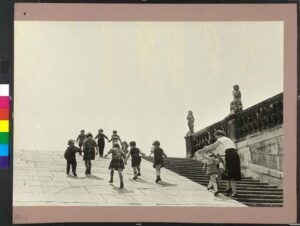
Diocesan Museum, Milan, May 9 – October 6, 2019
 It’s truly inexplicable how the first exhibition of the Magnum photo agency, which was presented in five German cities between 1956 and 1957, has been forgotten for fifty years. The artwork was found by sheer chance only in 2006 inside two boxes which contained, in addition to the photographs, coloured panels and some documents presenting the instructions on how to arrange the materials. This is absolutely amazing.
It’s truly inexplicable how the first exhibition of the Magnum photo agency, which was presented in five German cities between 1956 and 1957, has been forgotten for fifty years. The artwork was found by sheer chance only in 2006 inside two boxes which contained, in addition to the photographs, coloured panels and some documents presenting the instructions on how to arrange the materials. This is absolutely amazing.
The Diocesan Museum decided to celebrate this first and important review entitled “Gesicht der Zeit” (meaning “Face of Time”) by exhibiting the 83 black and white vintage prints. These play an important historic role, as well as documenting Magnum’s importance. The agency, famous on an international level, was created in 1947 by four different individuals, who shared the same political faith and the same drive to create something new and revolutionary, even if they had different talents, technical approaches and creative processes. They defended the value of photojournalism as a historic and artistic document and by doing so they challenged the editorial giants. These founders were: Endre Friedmann , alias Robert Capa, David Seymour, Henri Cartier-Bresson and George Rodger. Three of them, together with other photographers, organized Magnum’s First, which the Diocesan Museum revisits following the original set up. The path of this show starts with the exhibition of the different documents and continues with a series of boxes, each containing reportage from the eight authors.
At the heart of the exhibition are the 18 photographs of Henri Cartier-Bresson. These are a testimony to the dramatic events following Indian Independence which occurred in Delhi between 1947 and 1948. The reportage was published in Life in 1948, and it immortalized the hope and desperation of millions of Indians who experienced and took part in the “quiet revolution”, the historic mission led by Mahatma Gandhi. The photographs which picture Gandhi’s last days and his cremation are dramatic and moving. Hundreds of thousands of Indians took part in the ceremony. They became a never-ending human tide, an uninterrupted sequence of crying men and women. These shots blatantly represent Cartier-Bresson’s creed, that taking pictures meant aligning head, eye and heart.
Another master of photojournalism was Robert Capa, who became famous thanks to a shot portraying a Spanish militiaman as he was surrendering to death during the civil war. Capa was essentially a war photographer and followed conflicts on various fronts from a close distance. His mantra was “If your pictures aren’t good enough, you aren’t close enough”. Sadly for him, this conviction caused his death. At only forty years old he stepped on an unexploded mine. In this exhibition, however, he did not present a war shot, but instead, three pictures depicting a Basque festival, which took place in Biarritz in 1951. The pictures, entitled “Village Festival”, show popular dances and their goal is to highlight how the region, devastated by the civil war, went back to peace and normality.
The exhibition follows with the shots of Hernst Haas, Erich Lessing, Werner Bischof, Jean Marquis, Inge Morath (who was the only woman working in the agency) and Marc Riboud. The review is the second most important photographic exhibition held by the Diocesan Museum.
Loretta Pettinato
volume 34 no 1 September – October 2019 p 25


Pop the cork! I had erroneously thought this was going to be an article about Magnum Spumante and thought it might be about artistic bottles. However, after my initial surprise, reading about this photo agency created in 1947 gave me some good information. Many thanks Loretta!